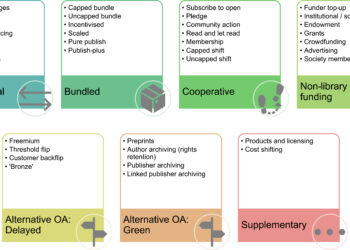The argument in recent years has been that “free” is a superb marketing technique, a way to get your product to stand out from its competitors. Science fiction author Cory Doctorow swears by it, having given away the full-text of all of his novels for free online. Radiohead and Nine Inch Nails received tons of publicity for their recent “pay what you want” efforts, which probably led to higher sales than standard channels. Chris Anderson of “Long Tail” fame has a book due out shortly touting “free” as the business strategy of the future.
But is “free” reaching the end of its value as a marketing scheme?
The San Jose Mercury News has announced they’ll soon be charging readers for online access, joining others like the Wall Street Journal and apparently most of Rupert Murdoch’s holdings. Networks are pulling their programs off of Hulu, with worries that free viewing will cut down on carriage fees and DVD sales.
As Kent Anderson noted in a recent post, the argument against putting your material behind a paywall is that it eliminates that material from being part of the online discussion, cuts it out of search engines, and takes away any potential traffic from blogs or other social networking sites. But for many content producers, the answer to that argument seems to be, “So what?” What good is it to be part of the online conversation if there’s no revenue generated from doing so? Does it matter if people can Twitter or blog about your content? Are you making any money whatsoever from those mentions? Can you expect to sell a subscription or a DVD if you’re already giving your content away for free online?
The problem is that as more and more content is made free, the market gets crowded, and being free is no longer enough to get your content noticed. Sure, Doctorow and the bands mentioned above got a lot of press coverage for their free efforts. But what happens to the next author or band to try this method? What about the tenth? The hundredth? When there are thousands of bands offering their output for free, does this business model lose its effectiveness? As Seth Godin writes:
The first time a previously expensive good or service is made free, we’re drawn to it precisely because of the freeness. The fifth time or tenth time, not so much. . . . Free by itself is no longer enough to guarantee much of anything.
There’s still probably some mileage left in “free,” at least in the short term in areas where it hasn’t been over-exploited. Godin makes clear that making some content free continues to be useful for sampling purposes, to lower the boundaries for trying out a product before purchasing. But as a marketing scheme to promote your content, its lifespan is limited. If everyone is doing it, it’s no longer a way to stand out. Once free loses it’s novelty, quality is going to win out. As Kate Bradley puts it, the “new free” is going to be “the opposite of free,” something so good you’d be willing to buy it at a premium.
And this is where the newspapers need to take note. Their problems with free content are compounded because they’ve reached a point where they’re all pretty much interchangeable. As Nat Torkington explains concerning the Mercury News:
This business model didn’t fail in 1998 because there weren’t enough people on the Internet, it failed for the same reason it will fail now: you have a generic product and a cheaper substitute will win.
These days, there’s very little that makes one newspaper stand out from the next. If they try to earn revenue by going subscription-only access, readers will just move to the next identical newspaper that remains free and the closed access paper will fail. The free papers have no way to make any money either, so they’ll eventually close as well. If this continues, the inevitable conclusion is that the winner will be the last newspaper standing, which will keep everything free until all competitors are gone, then go to a subscription model.
The solution is to do something to make your product stand out from the crowd. Cutting costs at the expense of quality journalism, relying on the same wire feeds that every other paper uses, and pandering to the lowest common denominator will not lead to success.
Give readers a reason to find your content indispensable and unique. Otherwise, you’re just playing a game of chicken, and the odds are not in your favor.
Discussion
6 Thoughts on "The End of “Free”"
what if the decline in paid newspaper subscriptions and free news content on the ‘intertubes’ are just a coincidence?
i just realized the other day, that by 1995 — when the internet was becoming hugely widespread and every search-engine search included more porn-links than not — i had been a full adult for more than 15 years.
i have *never* subscribed to a newspaper. kind of got me wondering how many others like me might be ‘out there’.
“But is “free” reaching the end of its value as a marketing scheme?”
I sure hope so. I much prefer the transparency used in public television where they state boldly “This program paid for by the [insert philathopic org name here] foundation.” Nothing is truly free and a scholarly audience should be interested in knowing a) that what is being provided has a cost and b) who is footing the bill.
David
I think you are spot on with your observation:
“Give readers a reason to find your content indispensable and unique”
Maybe we need to relook at the equation. Doesn’t matter whether your content is free or paid, if it’s crap, not relevant, not useful, then noone will read it.
Presuming you are creating content that someone wants and needs, then the argument between paid and free is, as the Mercury News person says, whether there is sufficient value in the content, its context and presentation to attract a paying crowd.
20 years ago I didn’t have CNN on cable TV. I didn’t have a plethora of internet news sources. And I read the newspaper everyday. Now I read online, and use tools like Google Reader to organise the information. Plus I subscribe to a couple of key online publications in my particular areas of interest.
Cheers…David
![Reblog this post [with Zemanta]](http://img.zemanta.com/reblog_e.png?x-id=a7035096-6761-484f-870a-bee352c75afb)


